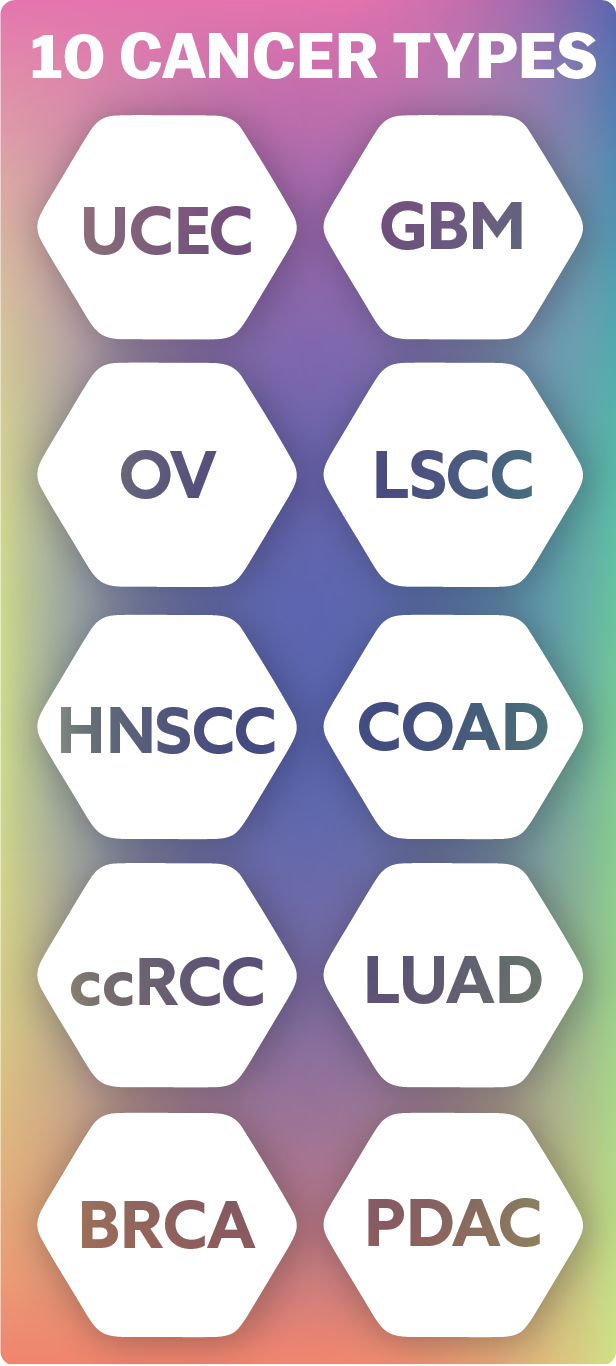The Clinical Proteomic Tumor Analysis Consortium (CPTAC) has performed proteogenomic characterization for over 1,000 primary tumors spanning 10 cancer types: breast invasive carcinoma (BRCA), clear cell renal cell carcinoma (CCRCC), colon adenocarcinoma (COAD), glioblastoma (GBM), head and neck squamous cell carcinoma (HNSCC), lung adenocarcinoma (LUAD), lung squamous cell carcinoma (LSCC), ovarian serous cystadenocarcinoma (OV), pancreatic ductal adenocarcinoma (PDAC), and uterine corpus endometrial carcinoma (UCEC) The CPTAC Pan-Cancer Resource Working Group has harmonized all omics data from these 10 cancer types for pan-cancer proteogenomics research. This paper is the most recent in a series of publications leveraging the CPTAC Pan-Cancer Dataset to improve our understanding of cancer.
 In a recent pan-cancer study, published in Cell, researchers from Baylor College of Medicine, Fudan University, China, and the Chinese Academy of Sciences used CPTAC proteogenomic data in combination with other large public datasets to identify and validate potential therapeutic targets across 10 cancer types. Their multi-omic analysis focused on overexpressed and hyperactivated proteins, tumor suppressor gene (TSG) loss-associated dependencies, as well as neoantigens and tumor-associated antigens. As a result, the group has generated a comprehensive resource of protein targets, linked here, and revealed opportunities for improving and developing cancer treatments.
In a recent pan-cancer study, published in Cell, researchers from Baylor College of Medicine, Fudan University, China, and the Chinese Academy of Sciences used CPTAC proteogenomic data in combination with other large public datasets to identify and validate potential therapeutic targets across 10 cancer types. Their multi-omic analysis focused on overexpressed and hyperactivated proteins, tumor suppressor gene (TSG) loss-associated dependencies, as well as neoantigens and tumor-associated antigens. As a result, the group has generated a comprehensive resource of protein targets, linked here, and revealed opportunities for improving and developing cancer treatments.
Researchers analyzed transcriptomic and proteomic data from the various cancer types to identify proteins that were significantly overexpressed in tumor tissues compared to normal tissues and essential for cell survival within cancer cell lines of the same lineage. Of these, the team identified 457 proteins-of-interest that were also considered druggable, with 51 of them being shared by at least 5 cancer types and representing strong candidates for drug repurposing/development. Beyond protein abundance, their analysis also incorporated protein activity inferred from phosphoproteomic data, uncovering additional druggable targets not identifiable through global proteomic approaches alone.
Protein dependencies resulting from loss-of-function (LOF) genomic aberrations in TSG’s occur frequently across cancer types, making them attractive targets for synthetic lethal therapeutic strategies. To identify TSG loss-associated dependencies, the researchers analyzed associations between TSGs with over 3% LOF alterations and variations in protein abundance, phosphosite abundance, and inferred kinase activity scores across tumor samples for each cancer type. In the context of TP53 loss, researchers found elevated TOP2A abundance and phosphorylation in uterine corpus endometrial carcinoma, ANAPC1 phosphorylation in ovarian serous cystadenocarcinoma, and increased CHK1 kinase activity in breast invasive carcinoma. Dependency on these proteins for survival was higher in TP53-mutant compared to wild type cell lines within the same cancer type, suggesting, suggesting their potential as targets for patients with TP53-mutant tumors.
The team identified neoantigens and tumor-associated antigens as valuable potential targets for immunotherapies, such as personalized cancer vaccines or engineered T-cells. Though the majority of neoantigen-yielding somatic mutations were patient-specific, researchers identified 5 mutant KRAS peptides capable of eliciting immune responses across multiple patients and 4 different cancer types , indicating their potential clinical utility. Notably, experimental validation of peptides with high affinity to HLA-A*02 identified other promising candidates, including peptides from less-studied proteins like BRDT and LEKR1.
Dr. Bing Zhang, co-corresponding author from Baylor College of Medicine commented, “Although there is progress identifying potential vulnerabilities of specific cancer types, fewer than 200 proteins are targeted by FDA-approved cancer drugs. We hope that this resource will pave the way to repurposing currently available drugs and developing new therapies for cancer treatment.”

